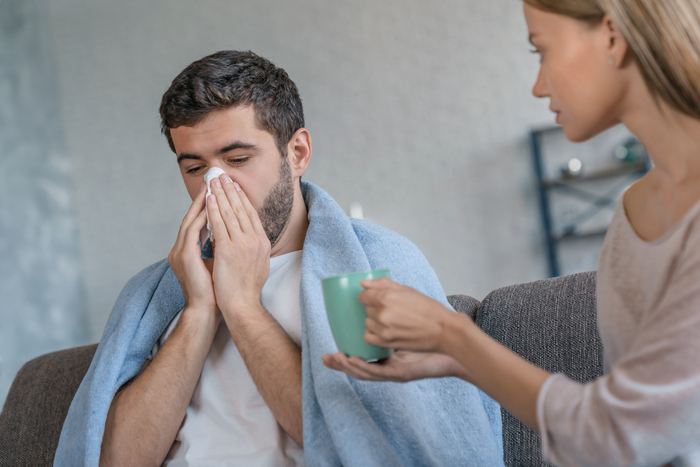Key points
- The flu is highly contagious, spreading through respiratory droplets, contaminated surfaces, or close contact with infected individuals.
- Flu-infected individuals are typically contagious from one day before symptoms begin until five to seven days after becoming sick.
- The flu is most contagious in the first few days after symptoms appear, with the risk of transmission decreasing significantly after the initial days of illness.
- Preventing flu spread involves good hygiene, avoiding crowded places, practicing respiratory etiquette, and getting the annual flu shot.

The flu is a highly contagious respiratory illness that can spread rapidly, especially in crowded environments, according to the CDC. They explain that understanding how the flu virus transmits from person to person is crucial in implementing effective prevention strategies. By recognizing the ways in which the flu spreads—whether through respiratory droplets, contaminated surfaces or close contact with infected individuals—you can take proactive measures to protect yourself and those around you. Continue reading to delve into the duration of flu contagion and provide practical tips on how to minimize the risk of transmission, ensuring a healthier community during flu season.
How long is the flu contagious?
The flu virus can be transmitted from person to person, and knowing how long an infected individual remains contagious can help mitigate outbreaks and protect vulnerable populations. The CDC notes that typically, individuals infected with the flu are contagious from about one day before symptoms begin until approximately five to seven days after becoming sick. This means that someone can unknowingly spread the virus even before they feel unwell. Children and those with weakened immune systems may remain contagious for a longer duration. Generally, once a person has been fever-free for at least 24 hours without the use of fever-reducing medications, they are considered no longer contagious.
When is someone with the flu most contagious?
The contagious period can vary, but certain stages of the illness are particularly critical in terms of transmission, according to the CDC. Individuals with the flu are most contagious in the first few days after symptoms appear, typically around days one to three of illness. During this time, the viral load in their respiratory secretions is at its highest, making it easier for the virus to spread through coughs, sneezes or even talking. While they may still be contagious for up to a week or more, the risk of transmission decreases significantly after the initial days of illness.
How is the flu spread?
The flu virus primarily spreads through respiratory droplets when an infected person coughs, sneezes or talks. According to the CDC, these droplets can be inhaled by people nearby or land on surfaces, where the virus can survive for a limited time. In addition to direct transmission through droplets, the flu can also spread indirectly. When a person touches a surface or object contaminated with the virus—such as doorknobs, light switches or shared utensils—and then touches their mouth, nose or eyes, they can become infected. Close contact with infected individuals, such as hugging or shaking hands, further increases the risk of transmission.
How to prevent getting the flu after exposure
Understanding how to prevent the flu after exposure is crucial for safeguarding your health and the well-being of those around you.
First and foremost, practicing good hygiene is essential. Wash your hands frequently with soap and water for at least 20 seconds, or use an alcohol-based hand sanitizer when soap is not available. Avoid touching your face, especially your eyes, nose and mouth, as this can facilitate the entry of the virus into your system. Additionally, the CDC recommends that you consider taking antiviral medications if recommended by a healthcare professional, as they can help reduce the likelihood of developing the flu after exposure. Staying vigilant about cleanliness, such as disinfecting commonly touched surfaces, and maintaining a healthy lifestyle—adequate sleep, nutrition and hydration—can further bolster your immune response and help prevent infection.
How to prevent flu spreads
Preventing the spread of the flu is essential for protecting both individual and public health, especially during flu season. By adopting a few key preventive measures, you can significantly reduce the risk of transmission and help keep your community safe. Effective strategies from the CDC include:
-
Get the flu shot: Annual vaccination is the most effective way to prevent the flu and its complications.
-
Wash your hands frequently: Regularly washing your hands with soap and water or using hand sanitizer can eliminate germs and reduce the risk of infection.
-
Avoid crowded places: Limiting exposure to crowded environments, especially during peak flu season, can help reduce the likelihood of encountering the virus.
-
Practice respiratory etiquette: Cover your mouth and nose with a tissue or your elbow when coughing or sneezing to prevent spreading droplets to others.
Urgent care near me
If you or a loved one is experiencing flu symptoms or need immediate medical attention, don't hesitate to seek care. Use Solv to find urgent care facilities near you quickly and easily.
FAQs
How long is a person contagious after contracting the flu?
An individual infected with the flu is typically contagious from one day before symptoms begin until approximately five to seven days after becoming sick. However, children and those with weakened immune systems may remain contagious for a longer duration.
When is a person with the flu most contagious?
Individuals with the flu are most contagious in the first few days after symptoms appear, typically around days one to three of illness. The risk of transmission decreases significantly after the initial days of illness.
How does the flu virus spread?
The flu virus primarily spreads through respiratory droplets when an infected person coughs, sneezes, or talks. It can also spread indirectly when a person touches a surface or object contaminated with the virus and then touches their mouth, nose, or eyes. Close contact with infected individuals also increases the risk of transmission.
What are some ways to prevent getting the flu after exposure?
Practicing good hygiene is essential to prevent getting the flu after exposure. This includes frequent handwashing, avoiding touching your face, and considering antiviral medications if recommended by a healthcare professional. Staying vigilant about cleanliness and maintaining a healthy lifestyle can also help prevent infection.
How can the spread of the flu be prevented?
Preventing the spread of the flu involves several strategies including getting the annual flu shot, washing hands frequently, avoiding crowded places, and practicing good respiratory etiquette such as covering your mouth and nose when coughing or sneezing.











